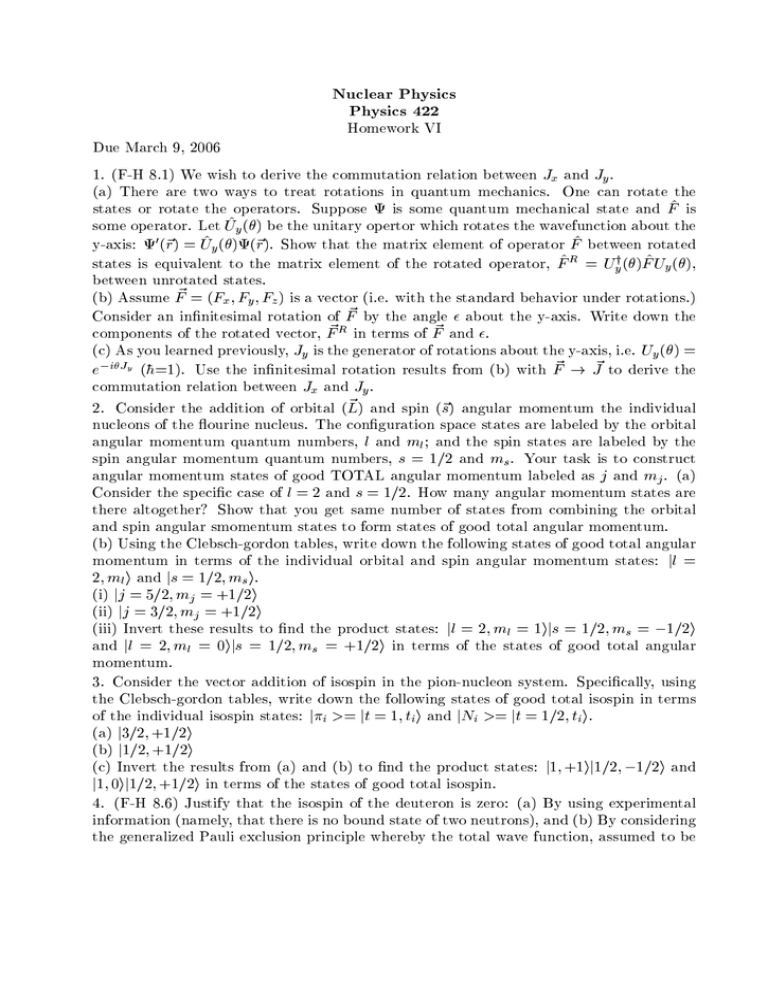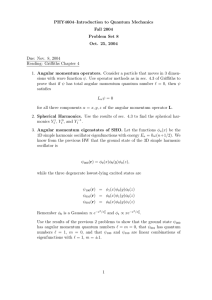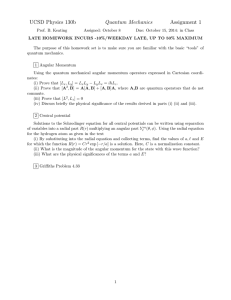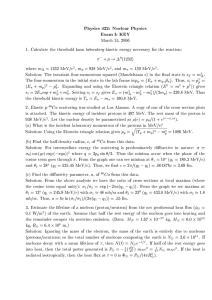Nuclear Physics Physics 422 Homework VI Due March 9, 2006
advertisement

Nuclear Physics Physics 422 Homework VI Due March 9, 2006 1. (F-H 8.1) We wish to derive the commutation relation between Jx and Jy . (a) There are two ways to treat rotations in quantum mechanics. One can rotate the states or rotate the operators. Suppose is some quantum mechanical state and F^ is some operator. Let U^y () be the unitary opertor which rotates the wavefunction about the y-axis: 0 (~r) = U^y ()(~r). Show that the matrix element of operator F^ between rotated states is equivalent to the matrix element of the rotated operator, F^ R = Uyy ()F^ Uy (), between unrotated states. (b) Assume F~ = (Fx ; Fy ; Fz ) is a vector (i.e. with the standard behavior under rotations.) Consider an innitesimal rotation of F~ by the angle about the y-axis. Write down the components of the rotated vector, F~ R in terms of F~ and . (c) As you learned previously, Jy is the generator of rotations about the y-axis, i.e. Uy () = ~ ! J~ to derive the e iJy ( h=1). Use the innitesimal rotation results from (b) with F commutation relation between Jx and Jy . 2. Consider the addition of orbital (L~ ) and spin (~s) angular momentum the individual nucleons of the ourine nucleus. The conguration space states are labeled by the orbital angular momentum quantum numbers, l and ml ; and the spin states are labeled by the spin angular momentum quantum numbers, s = 1=2 and ms . Your task is to construct angular momentum states of good TOTAL angular momentum labeled as j and mj . (a) Consider the specic case of l = 2 and s = 1=2. How many angular momentum states are there altogether? Show that you get same number of states from combining the orbital and spin angular smomentum states to form states of good total angular momentum. (b) Using the Clebsch-gordon tables, write down the following states of good total angular momentum in terms of the individual orbital and spin angular momentum states: jl = 2; ml i and js = 1=2; ms i. (i) jj = 5=2; mj = +1=2i (ii) jj = 3=2; mj = +1=2i (iii) Invert these results to nd the product states: jl = 2; ml = 1ijs = 1=2; ms = 1=2i and jl = 2; ml = 0ijs = 1=2; ms = +1=2i in terms of the states of good total angular momentum. 3. Consider the vector addition of isospin in the pion-nucleon system. Specically, using the Clebsch-gordon tables, write down the following states of good total isospin in terms of the individual isospin states: ji >= jt = 1; ti i and jNi >= jt = 1=2; ti i. (a) j3=2; +1=2i (b) j1=2; +1=2i (c) Invert the results from (a) and (b) to nd the product states: j1; +1ij1=2; 1=2i and j1; 0ij1=2; +1=2i in terms of the states of good total isospin. 4. (F-H 8.6) Justify that the isospin of the deuteron is zero: (a) By using experimental information (namely, that there is no bound state of two neutrons), and (b) By considering the generalized Pauli exclusion principle whereby the total wave function, assumed to be the product of the space (orbital angular momentum), spin, and isospin parts, must be antisymmetric under exchange of the two nucleons. Treat the proton as isospin \up" and the neutron as isospin \down". Use the fact that the spin of the deuteron is one and it has positive parity. 5. (Read section 14.2) Consider + N ! + N scattering via an isospin-conserving interaction. The pion has I=1 while the nucleon has I=1/2. Therefore there are 3 x 2 = 6 possible initial states and 6 possible nal states giving a total of 36 possible experiments. How many of these are excluded by charge conservation? (recall that Iz is related to the charge.) Which of these are related by time-reversal? Which of these are related by charge conjugation? How many of these 36 possible experiments are really independent if isospin is conserved? (see F-H problem 14.1)







